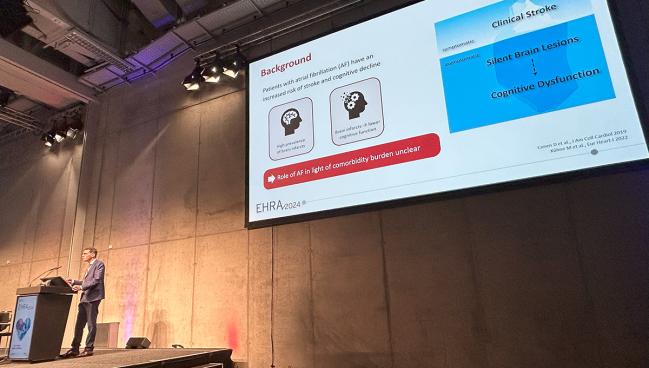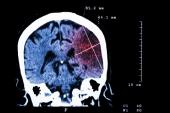Study Bolsters AF’s Link to Brain Infarcts, Cognitive Impairment
Fighting for sinus rhythm might be crucial for the essential social needs of patients with the arrhythmia, one expert says.

BERLIN, Germany—Patients with atrial fibrillation (AF) are more likely than similar individuals without the arrhythmia to have brain infarcts detected on MRI, an analysis of the Swiss-AF cohort study affirms.
Moreover, AF patients had worse cognitive function even after accounting for numerous potential confounders, Michael Kühne, MD (University Hospital Basel, Switzerland), reported here at the European Heart Rhythm Association Congress 2024.
“I believe this is robust and new evidence that AF is not only a marker of comorbidity . . . but that the arrhythmia—AF—per se matters and is associated with more brain infarcts and more cognitive decline compared to patients without atrial fibrillation,” he said. “This suggests that we should take AF seriously and that we should take care of AF, probably by means beyond oral anticoagulation.”
The study helps clarify the interplay between AF, brain infarcts, and cognitive dysfunction, Kühne indicated. Studies have shown that patients with AF have greater risks of stroke and cognitive decline, as well as a high prevalence of MRI-detected brain infarcts, which are associated with cognitive impairment. “The clinical stroke in this context may only be the tip of the iceberg,” Kühne said. “What lurks beneath the surface is malignant, and these are the clinically silent brain lesions, and these are associated with cognitive dysfunction.”
The clinical stroke in this context may only be the tip of the iceberg. Michael Kühne
Previously, the Swiss-AF cohort had lacked a control group, so the influence of AF itself on the presence of brain infarcts and cognitive dysfunction, in the context of a high comorbidity burden, has remained unclear, he said.
To delve deeper, the investigators, working across 14 Swiss centers, compared 1,732 patients with AF enrolled in the Swiss-AF study between 2014 and 2017 (mean age 72.5 years; 27% women) with 963 patients without AF enrolled in an extension cohort between 2018 and 2023 (mean age 74.1 years; 37% women). All participants were 65 or older and were free from acute illness at the time of inclusion. They underwent standardized brain imaging for the assessment of both cortical and noncortical brain infarcts, with central adjudication by a core lab, and standardized cognitive testing with the Montreal Cognitive Assessment (MoCA), which is scored from 0 (worst) to 30 (best).
The presence of any brain infarct was more common among patients with versus without AF both in the overall cohort (36.7% vs 23.9%) and in the subset without prior clinical stroke/TIA (28.5% vs 19.4%).
After adjustment for age, sex, body mass index, active smoking, hypertension, diabetes, educational status, and oral anticoagulation, patients with AF had greater odds of having any infarcts (OR 1.72; 95% CI 1.28-2.33) and clinically silent infarcts (OR 1.87; 95% CI 1.31-2.65).
On average, patients with AF scored roughly 1 point lower on the MoCA than did those with normal sinus rhythm, which “does not seem like a lot but actually corresponds to about one decade of loss in cognition during normal aging,” Kühne said.
These findings were consistent irrespective of whether patients had paroxysmal or nonparoxysmal AF.
‘Inspirational’ Findings
Kühne acknowledged that the study has some limitations, including the observational and cross-sectional design; the lack of information on when the brain infarcts occurred; uncertain generalizability to other populations; and the lack of continuous rhythm monitoring in participants without AF.
Nonetheless, Maciej Sterliński, MD, PhD (National Institute of Cardiology, Warsaw, Poland), who served as the discussant following the presentation, said he was inspired by the findings. He pointed to prior research showing that restoration of sinus rhythm improves brain perfusion and that use of ablation is associated with a lower risk of dementia compared with medical therapy.
Yet the struggle for sinus rhythm remains a big challenge for the medical community, he said.
Speaking with TCTMD, Sterliński stressed that AF is a complex problem, noting that several abstracts focusing on the cognitive and social function of patients with the arrhythmia have been submitted for the European Society of Cardiology Congress later this year.
[There is] absolutely more and more proof that fighting for sinus rhythm might be crucial for the essential social needs of patients. Maciej Sterliński
There is, he said, “absolutely more and more proof that fighting for sinus rhythm might be crucial for the essential social needs of patients, and this is not [over] a horizon of 3 to 5 years. Probably the robust activities that we are undertaking today to restore and to sustain sinus rhythm in let’s say middle-aged patients and patients entering the elderly [stage] will pay off [over] a horizon of 20 years, 30 years, etc.”
He highlighted the importance of educating patients and medical staff about the proper diagnosis of AF and appropriate treatment with drugs and invasive therapy, with a particular focus on achieving rhythm control.
Studies like this, Sterliński said, provide education about a specific aspect of AF, “but this is the inspiration as well to further investigations and further rethinking of some problems—what we can do better, what we have lost, and which direction we should go in.”
Todd Neale is the Associate News Editor for TCTMD and a Senior Medical Journalist. He got his start in journalism at …
Read Full BioSources
Kühne M. Impact of atrial fibrillation on brain infarcts and cognitive function: a matched cohort analysis. Presented at: EHRA 2024. April 7, 2024. Berlin, Germany.
Disclosures
- The study was supported by the Swiss National Science Foundation and the Swiss Heart Foundation.
- Kühne reports consulting fees from Abbott, Boston Scientific, and Daiichi Sankyo; book royalties from Springer; and grants from Bayer, BMS, Boston Scientific, Daiichi Sankyo, Pfizer, the Swiss National Science Foundation, the Swiss Heart Foundation, the Mach-Gaensslen Foundation, the University of Basel, and the Foundation for Cardiovascular Research Basel.





Comments